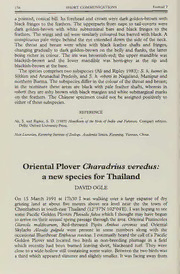
Oriental plover Charadrius veredus: a new species for Thailand PDF
Preview Oriental plover Charadrius veredus: a new species for Thailand
156 SHORT COMMUNICATIONS Forktail 7 a pointed, conical bill. Its forehead and crown were dark golden-brown with black hinges to the feathers. The upperparts from nape to tail-coverts were dark golden-brown with white subterminal bars and black fringes to the feathers. The wings and tail were similarly coloured but barred with black. A conspicuous pale stripe behind the eye extended down the side of the neck. The throat and breast were white with black feather shafts and fringes, changing gradually to dark golden-brown on the belly and flanks, the latter being richer in colour. The iris was brownish-red; the upper mandible was blackish-brown and the lower mandible was horn-grey at the tip and blackish-brown at the base. The species comprises two subspecies (Ali and Ripley 1983): S. h. humei in Sikkim and Arunachal Pradesh, and S', h. roberti in Nagaland, Manipur and northern Burma. The subspecies differ in the colour of the throat and breast; in the nominate these areas are black with pale feather shafts, whereas in roberti they are ashy brown with black margins and white submarginal marks on the feathers. The Chinese specimen could not be assigned positively to either of these subspecies. REFERENCE * Ali, S. and Ripley, S. D. (1983) Handbook of the birds of India and Pakistan. Compact edition. Delhi: Oxford University Press. Han Liawcian, Kunming Institute of Zoology, Academia Sinica, Kunming, Yunnan, China. Oriental Plover Charadrins veredus: a new species for Thailand DAVID OGLE On 15 March 1991 at 17h30 I was walking over a large expanse of dry grazing land at about five metres above sea level near the the town of Chanthaburi in south-east Thailand (12°37'N 102°04'E). I was hoping to see some Pacific Golden Plovers Pluvialis fulva which I thought may have begun to arrive on their annual spring passage through the area. Oriental Pratincoles Glareola maldivarum, Red-throated Pipits Anthus cervinus and Oriental Skylarks Alauda gulgula were present in some numbers along with the occasional Bluethroat Erithacus svecicus. I eventually heard the call of a Pacific Golden Plover and located two birds in non-breeding plumage in a field which recently had been burned leaving short, blackened turf. They were close to a wide hollow still containing some water. Between the two birds was a third which appeared slimmer and slightly smaller. It was facing away from 1992 SHORT COMMUNICATIONS 157 me and presented brown, unmarked upperparts. When it turned towards me, however, I was amazed to see orange and brown markings on its breast and knew I was looking at a male Oriental Plover Charadrius veredus in full breeding plumage. The following description was taken: the crown of the head, back and tail were all a uniform brown. The hind nape was pale grey. The facial area, neck and throat were very pale and almost white. The upper breast was yellowish grading to light orange then dark orange. This was bordered by a very dark brown line across the lower breast. The underparts were pure white, the bill dark and the legs brownish-yellow. On a subsequent visit, a thin off-white wing bar could be seen when the bird was in flight. The bird was very active when feeding, making quick runs then stopping for a few seconds before moving off again. The nearby Pacific Golden Plovers, on the other hand, remained still the whole time, apparently roosting. Two weeks later, on 29 March, there were six Oriental Plovers present. Five of these were in the plumage of breeding males while the sixth individual was in non-breeding plumage. There were still three birds present on 2 April. The Oriental Plover is a long distance migrant, breeding in north China and Mongolia, and wintering in Indonesia and northern Australia (Hayman et al. 1986). Its migration route follows the eastern seaboard of the Asian continent, although there are records of a single individual collected in the Andaman Islands in the last century (Ali and Ripley 1983) and of birds found in the Coco Islands and Malaya. It is quite possible that Oriental Plovers are annual passage migrants in Thailand but have been overlooked through the lack of observers. There have been unconfirmed reports of sightings in Khao Sam Roi Yot (P. Round in litt.) and in Chanthaburi in 1975 (pers. obs.), and this species had been expected to appear in the country before long (Lekagul and Round 1991). This record of the Chanthaburi birds in 1991 is, therefore, the first documented evidence of the Oriental Plover in Thailand. REFERENCES Ali, S. and Ripley, S.D. (1983) Handbook of the birds of India and Pakistan. Compact Edition. Delhi: Oxford University Press. Hayman, P., Marchant, J. and Prater, T. (1986) Shorebirds: An identification guide to the waders of the world. London: Croom Helm. Lekagul B. and Round, P. D. (1991) A guide to the birds of Thailand. Bangkok: Saha Bhaet Co., Ltd. David Ogle, 83 Carr Lane East, Liverpool Lll 4SG, U.K..
